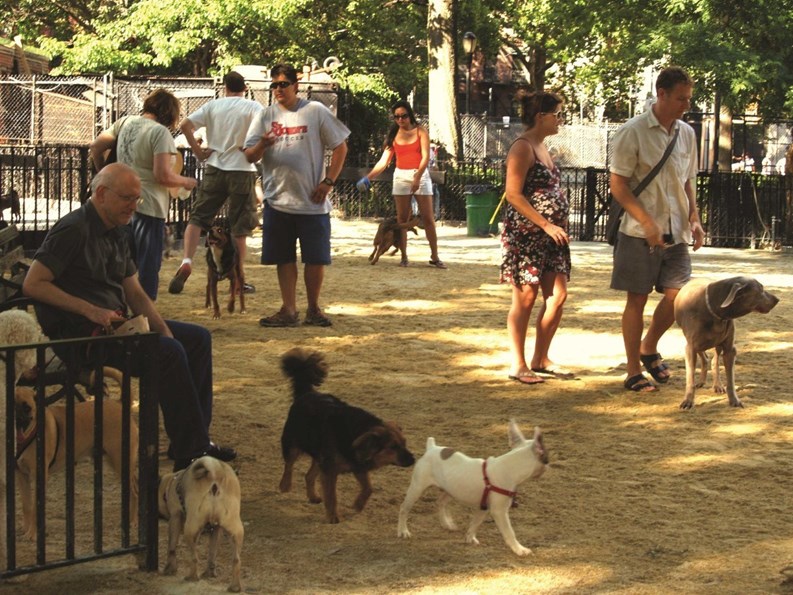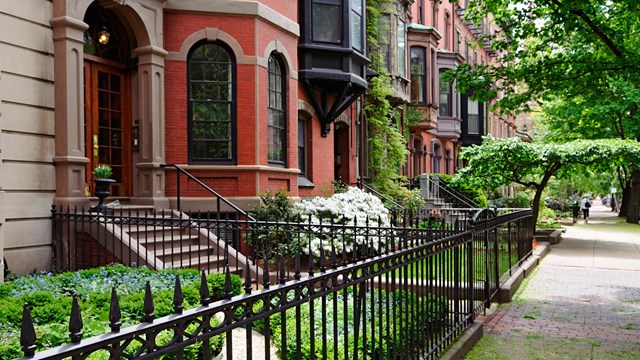Pet owners certainly love their dogs and consider them a part of the family. With an estimated 40,000 dogs in the city of Boston alone, (as per allstateanimalcontrol.com), it’s no wonder businesses and city dwellings are jumping on the dog-service bandwagon.
Our canine counterparts play an important part in the, not only day-to-day, but larger life decisions we make. Where to live? Why live there? And what’s in it for Fido? The easier a condominium building can make it on a dog owner to care for the family pooch, the greater the chance of buying real estate in their buildings. So the 12 off-leash dog runs located across Boston and countless others across New England may play a large role in the demographic of a particular neighborhood or building.
A surefire way to attract this market-share is to develop urban green spaces that exist or have the potential to create dog friendly off-leash areas. Massachusetts, Connecticut and New Hampshire all have laws which require dogs to be leashed at all times with the exception of designated areas. Other New England states prohibit dogs from running at large but do not specifically require dogs to be on a leash.
One of the first New England area dog runs appeared in Somerville, Massachusetts in 2006 after resident Michele Biscoe decided to adopt a dog and visited all the open spaces in her neighborhood and found that they were all posted “No Dogs Allowed.” She began to meet lots of neighbors, who, like her, had no place in the neighborhood they could safely and legally allow their dogs to play off-leash. Biscoe and a group of fellow dog lovers founded Somerville Dog Owners Group and helped transform the city’s laws—and its attitude. Today Somerville residents—both two- and four-legged —enjoy a fenced- in dog park at Nunziato Field, a tree-studded park not far from Tufts University. The “No Dogs Allowed” signs are gone, replaced by a new message that says dogs are welcome—on a leash.
“Starting a dog park wasn’t always easy. Somerville wasn’t always the friendliest place for dogs,” says Biscoe. “It’s time for city governments to recognize dog owner’s rights. Public open space must serve the many and diverse recreational needs of all residents.”
Dog runs are the fastest growing segment of city parks. According to a 2011 study by the non-profit Trust for Public Land, there were 569 off-leash dog parks in the 100 largest American cities in 2010, a 34% jump in 5 years. The increase reflects demographic shifts: There are now more households with dogs (43 million) than with kids (38 million).
It’s no secret that New Englanders love their dogs. Boston ranked No. 6 on the 2010 list of the top 10 most dog-friendly U.S. cities according to DogFriendly.com. (Rankings were based on number of outdoor restaurants, shopping and public transportation that welcomes canines. In Beantown, you can take your dog sailing for free on the Boston Harbor Islands Dog Cruise. The three-hour excursion is designed specifically for dogs and their owners. There are also island getaways for pooches with the City Water Taxi’s Island Romp for dogs.
“Generally speaking, more and more co-ops and condos are becoming more dog-tolerant. I’m seeing more acceptability with pets,’” says Isaiah Baril-Dore, a property manager with Premier Property Solutions in Boston. “A lot of people who buy condominiums are younger couples who want to have dogs for their kids.”
Many Boston buildings are pet-friendly and have nearby or on-premises dog runs. One such building is Wilkes Passage, a seven-story contemporary condo containing 159 loft-style units. This full service complex boasts 24-hour concierge and security, an underground parking garage with bike storage, a 6,000-square-foot common roof deck with stunning views of the Boston skyline, two luxury elevators and a pet-friendly policy. Some homes enjoy a private outdoor terrace and a newly landscaped park offers outdoor sporting activities, a playground and a dog run.
Another prominent Boston building, The Macallen, which is the first LEED-certified building in the city, also is pet-friendly. Amenities include a swimming pool, private outdoor space, private movie theater, an on-site fitness center and 24-hour concierge, along with a private dog run.
Site location is an essential element for a successful, popular dog run, says James Howard, a design coordinator responsible for designing dog runs in New Jersey and several other states.
“Essentially all dog runs share in the common goal to promote play and health for the dog. It should encourage exercise and fun,” says Howard. “But if the run is exposed to a lot of sun, then you’ll want to incorporate a portion of the run to be covered for shade. A run should have excellent drainage and discourage rain water runoff and assures the safe and secure housing of the dog.”
Designing dog runs now necessitates consideration for the dog owners as well as the dog. In urban areas especially human socialization plays a large a role in a successful dog run. Many dog runs now have vestibule-type entrances. This is a double opening where one gate opens by either sliding or swinging out so that it may be closed before entering the area where the dogs are.
Howard’s design for a canine complex in Parsippany, New Jersey features separate entrances for large and small dogs and separate activities for each size. The run also has a shade tree oasis, a dog water fountain, lots of benches, a paving stone patio and visitor’s kiosk, and a fenced in “doggie time-out area” for disobedient canines. His ideas were shaped by research based on dog parks in the Garden State communities of Denville, Roxbury and Randolph as well as across the Northeast.
“There are always one or two dogs misbehaving,” says Howard. “The ‘time-out’ area is something that’s offered by no other parks around here that I know of. This park features the best of what’s being offered at other dog parks as well as what should be offered.”
“One of the first things to consider when designing a dog park is the size and characteristic of the dog,” says Howard. “For example, if the dog is a digger and the run is erected on grass or soil, then you’ll want to incorporate a durable liner or pavers. A designer also must consider the terrain, and whether the run will be a freestanding structure or be erected as an extension of the present infrastructure.”
The turf used in dog runs is also a key ingredient. Paw-friendly crushed stone or sand seems to be the choice du jour, but asphalt covered in a painted-on material called 'sports coat' is used in some parks. The crushed stone option is a safe material that doesn’t turn into mud when wet and is comfortable for the animals to play on but it does need to be raked and evened out on a regular basis. The asphalt is virtually maintenance-free, with the exception of an occasional power wash.
A common turf-choice misstep among early dog run designs was the use of mulch or wood chips. This material can prove costly as it needs to be replaced often thanks to enthusiastic dogs kicking the material outside the fence and exposing the bare surface underneath. Most urban dog runs now offer at least one area where running water is available, although some of the larger and more popular runs have a few stations. These areas are there not only to help keep the dogs clean, cool and hydrated but also supplement maintenance and cleanup efforts. Depending upon the type of turf in the run as well as access to water, hosing down the area in the evenings a couple times a week can assist in keeping things looking their best.
Aside from the obvious daily maintenance, urban dog parks are remarkably maintenance-free. Clearing leaves in the fall and snow in the winter from the inside the fenced area is really the only seasonal concern.
At the end of the day, dog owners are drawn to these spaces so their pets can have some valuable off-leash fun and exercise each day. Like their human counterparts, dogs want to socialize, have fun and play and dog runs are outlets for them to do just that in a safe, well monitored environment.
David Garry is a freelance writer and a contributor to New England Condominium. Staff Writer Christy Smith-Sloman contributed to this article.






Leave a Comment